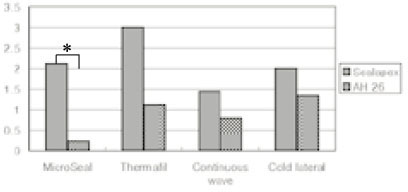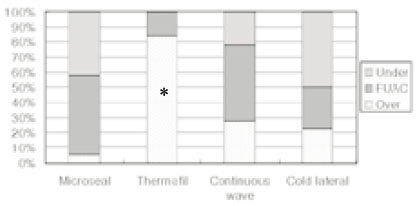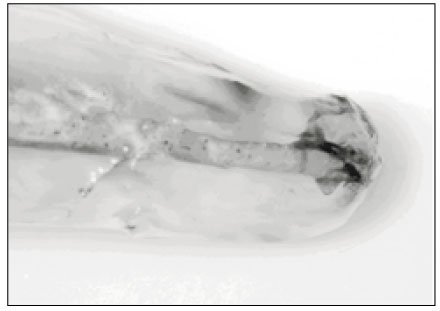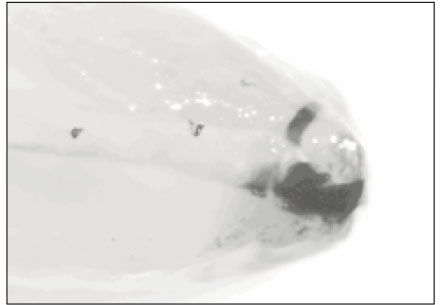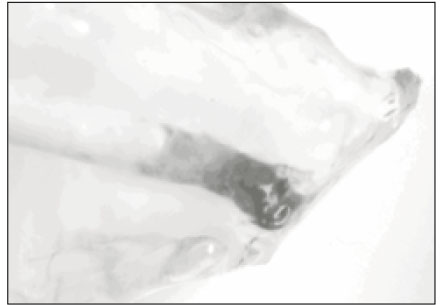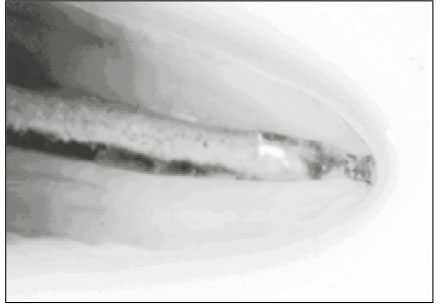J Korean Acad Conserv Dent.
2002 May;27(3):290-298. 10.5395/JKACD.2002.27.3.290.
Comparative study on the apical sealing ability according to the obturation techniques
- Affiliations
-
- 1Department of Conservative Dentistry, Oral Biology Research Institute, College of Dentistry, Chosun University, Korea.
- KMID: 1987288
- DOI: http://doi.org/10.5395/JKACD.2002.27.3.290
Abstract
- No abstract available.
Figure
Cited by 2 articles
-
Microleakage of resilon by methacrylate-based sealer and self-adhesive resin cement
Sun-Young Ham, Jin-Woo Kim, Hye-Jin Shin, Kyung-Mo Cho, Se-Hee Park
J Korean Acad Conserv Dent. 2008;33(3):204-212. doi: 10.5395/JKACD.2008.33.3.204.Prognostic factors influencing clinical outcome of nonsurgical endodontic treatment
Seonah Kim
J Korean Acad Conserv Dent. 2010;35(6):436-444. doi: 10.5395/JKACD.2010.35.6.436.
Reference
-
1. Yoo HJ, Hong CU. The effect of obturation techniques on the apical microleakage of root canals. J Korean Acad Conserv Dent. 1998. 23:213–220.2. Lim DY, Lee HJ, Hur B. Comparison of the influence of canal curvature on the sealing ability of lateral condensation and system B™. J Korean Acad Conserv Dent. 1999. 24:482–488.3. Beatty RG, Baker PS, Haddix J, Hart F. The efficacy of four root canal obturation techniques in preventing apical dye penetration. JADA. 1989. 119:633–637.
Article4. Benner MD, Peters DD, Grower M, Bernier WE. Evaluation of a new thermoplastic gutta-percha obturation technique using Ca. J Endod. 1981. 7:500–508.
Article5. Buchanan LS. The continuous wave of obturation technique. Dentistry Today. 1996. 15:60–67.6. Carlos CS. Apical Sealing Using Two Thermoplasticized Gutta-Percha Techniques Compared with Lateral Condensation. J Endod. 1997. 23:636–638.
Article7. Chohayeb AA. Comparison of conventional root canal obturation techniques with Thermafil obturators. J Endod. 1992. 1:10–12.
Article8. Delivanis PD, Mattison GD, Mendel RW. The survivality of F43 strain of streptoccus sanguis in root canals filled with gutta-percha and procosol camen. J Endod. 1983. 9:407–410.
Article9. Dilek MD, Larz SW. Comparison of Apical leakage in Root Canals Obturated with Various Gutta-percha Techniques Using a Dye Vacuum Tracing Method. J Endod. 1994. 20:315–319.
Article10. Edmund HK, Harrington GW. The effect of immediate post preparation on apical seal. J Endod. 1981. 7:325–329.11. Goldberg F, Massone EJ, Artaza LP. Comparison of the sealing capacity of three endodontic filling techniques. J Endod. 1995. 21:1–3.
Article12. Gutmann JL. Adaptation of injected thermoplasticized gutta-percha in the absence of smear layer. Int Endod J. 1993. 26:87–92.
Article13. Hata G. Sealing ability of thermoplasticized guttapercha fill techniques as assessed by a new method of determing apical leakage. J Endod. 1995. 21:167–172.
Article14. Ingle JI. Endodontics. 1978. 3rd ed. Philadelphia: Lea & Febiger;27–53.15. Haddix JE, Jarrell M, Mattison GD, Pink FE. An in vitro investigation of the apical seal produced by a new thermaplasticized gutta-percha obturation technique. Quintessence Int. 1991. 22:159–163.16. Johnson WB. A new gutta-percha technique. J Endod. 1978. 4:184–188.
Article17. Kazemi RB, Safari KE, Spanberg LS. Dimensional changes of endodontic sealers. Oral Surg Oral Med Oral Pathol. 1993. 76:766–771.
Article18. Kersten HW, Morrer WR. Particles and molecules in endodontic leakage. Int Endod J. 1989. 22:118–124.
Article19. Korzen BH. Endodontic Obturation using the Microseal Technique. Oral Health. 1997. 87:67–70.20. Kytridou V, Gutmann JL, Vunn MH. Adaptation and sealability of two contemporary obturation techniques in the absence of the dentinal smear layer. Int Endod J. 1999. 32:464–474.
Article21. LaCombe JS. A comparison of the apical seal produced by the thermoplasticized injectable gutta-percha technique. J Endod. 1988. 14:445–450.
Article22. Lares C, ElDeeb ME. The sealing ability of the Thermafil obturation technique. J Endod. 1990. 16:474–479.
Article23. Limkangwalmongkol S, Burtscher P, Abbot PV, Sandler AB, Bishop BM. A comparison study of the apical leakage of four root canal sealers and laterally condensed gutta-percha. J Endod. 1991. 17:495–499.
Article24. Matloff IR, Jensen JR, Singer L, Tabibi A. A comparison of methods in root canal seability studies. Oral Surg. 1982. 32:203–208.25. Naidorf IJ. Cinical microbiology in endodontics. Dent Clin North Am. 1974. 18:329–344.26. O'Neil KJ, Pitts DL, Harrington GW. Evaluation of the apical seal produced by the McSpadden compactor and lateral condensation with a chloroformsoftened primary cone. J Endod. 1983. 9:190–197.27. Osins BA, Carter M, Shih-Levine M. Microleakage of four root canal sealer cements as determined by an electrochemical technique. Oral Surg. 1983. 56:80–88.
Article28. Pathomvanich S, Edmunds DH. The sealing ability of Thermafil obturation assesed by four different microleakage techniques. Int Endod J. 1996. 29:327–334.
Article29. Peters DD. Two-year in in vitro solubility evaluation of four gutta-percha sealer obturation techniques. J Endod. 1986. 12:139–145.
Article30. Pitt Ford TR. Relation between seal of root fillings and tissue response. Oral Surg Oral Med Oral Pathol. 1983. 55:291–294.
Article31. Schilder H. Filling root canals in three dimensions. Dent Clin North Am. 1967. 11:723–744.
Article32. Schroeder A. Zum problem der backteriendichten Wurzenlkanalversorgung. Zahn Welt Zahn Ref. 1957. 58:531–537.33. Scott AC, Vire DE, Swanson R. An evaluation of the Thermafil endodontic obturation technique. J Endod. 1992. 18:340–343.
Article34. Spangberg LS, Acierno TG, Cha BY. Influence of entrapped air on the accuracy of leakage studies using dye penetraion methods. J Endod. 1989. 15:548–551.35. Tagger M, Tagger E. Realse of calcium and hydroxyl ions from set endodontic sealers containing calcium hydroxide. J Endod. 1988. 14:588–591.
Article36. Tagger M, Katz A, Tames A. Apical seal using the GPll method in straight canals compared with lateral condensation, with or without sealer. Oral Surg Oral Med Oral Pathol. 1994. 78:225–231.
Article37. Tanzilli JP, Raphael D, Moodnik RM. A comparison of the marginal adaptation of retrograde techniques : a scanning electron microscopic study. Oral Surg Oral Med Oral Pathol. 1980. 50:74–80.
Article38. Wiener BH, Schilder H. A comparative study of important physical properties of various root canal sealers II. Evaluation of dimensional changes. Oral Surg Oral Med Oral Pathol. 1971. 32:928–937.
Article39. Wu MK, Wesselink PR. Endodontic leakage studies reconsidered Part I. Methology, applicationand relevance. Int Endod J. 1993. 26:37–43.
Article
- Full Text Links
- Actions
-
Cited
- CITED
-
- Close
- Share
- Similar articles
-
- Effectiveness of customized master cone on apical sealing in various apical size of prepared root canals
- Comparison of apical seal with or without the use of dentin adhesive system
- Comparison of sealing ability of different obturation techniques in type II root canals
- Comparison of apical sealing efficacies using different plugging depth in continuous wave of obturation technique
- Comparison of apical sealing ability of continuous wave of obturation technique using EndoTwinn and System B

